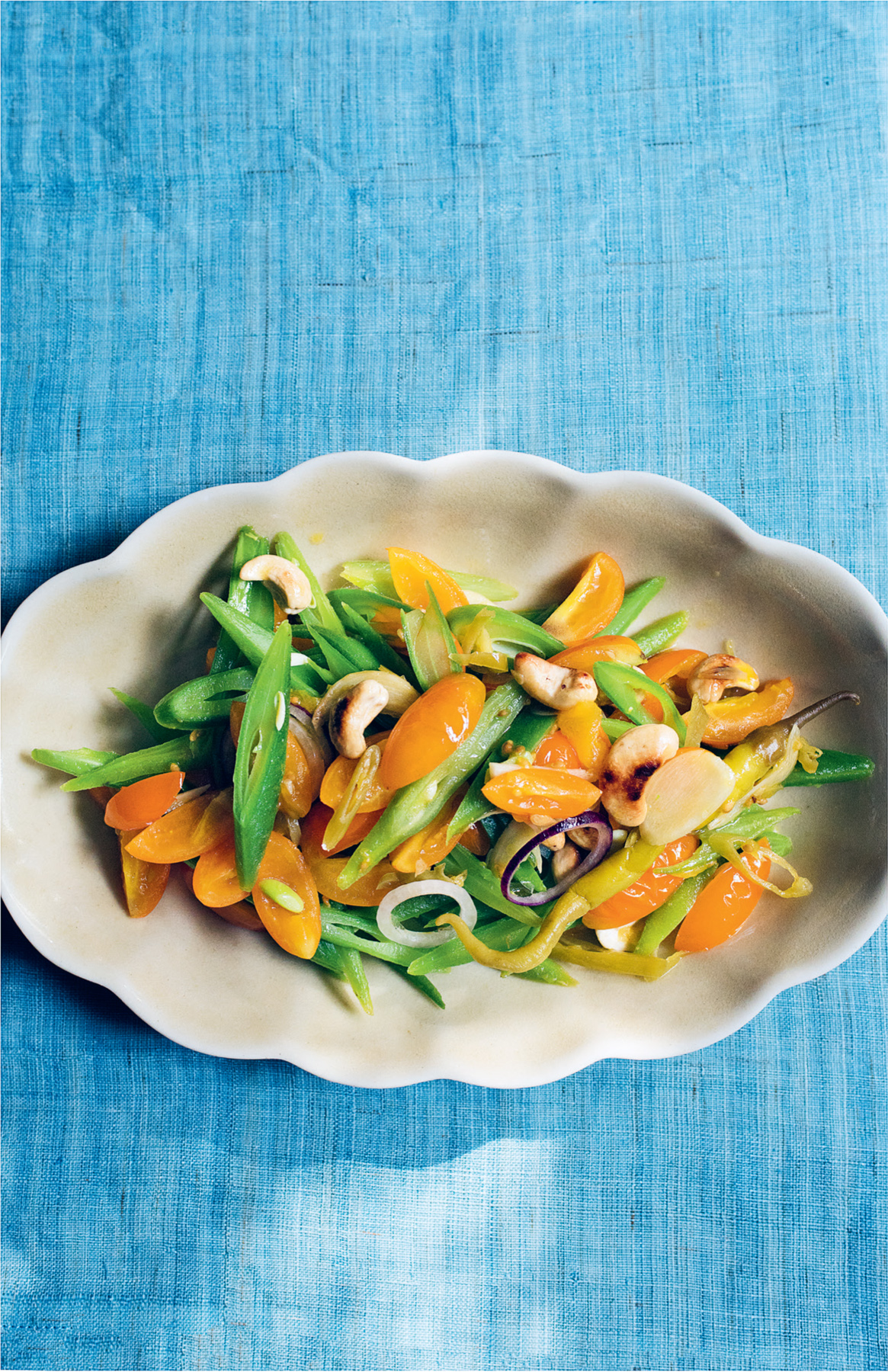
Полная версия
GreenFeast
ginger a 3cm lump, peeled
hot green chillies 3 small
groundnut oil 3 tablespoons
fresh coriander a handful, with roots
groundnut oil 1 tablespoon
vegetable stock 200ml
coconut milk 250ml
fish sauce 1 tablespoon
lime juice 2 tablespoons
spring vegetables (such as asparagus tips, broad beans, peas) 450g total weight
shredded greens, such as spring cabbage a handful
pinch of sugar and soy sauce
For the paste, put the white peppercorns and coriander seeds in a dry non-stick frying pan and toast lightly for two or three minutes, then tip into the bowl of a food processor and add half a teaspoon of sea salt, the turmeric, lemon grass, peeled garlic cloves, ginger, green chillies, three tablespoons of groundnut oil and a handful of coriander stems and roots. Blitz to a coarse paste. You can keep this paste for a few days in the fridge, its surface covered with groundnut oil to prevent it drying out.
In a deep pan, fry three lightly heaped tablespoons of the curry paste in a tablespoon of oil for thirty seconds till fragrant, stirring as you go. Stir in the vegetable stock and coconut milk, the fish sauce and lime juice.
Add the asparagus tips, broad beans and peas and continue simmering for five to six minutes, then drop in a couple of handfuls of greens, shredded into thick ribbons. Finish the curry with a pinch of sugar, fish sauce, a little soy sauce and more lime.
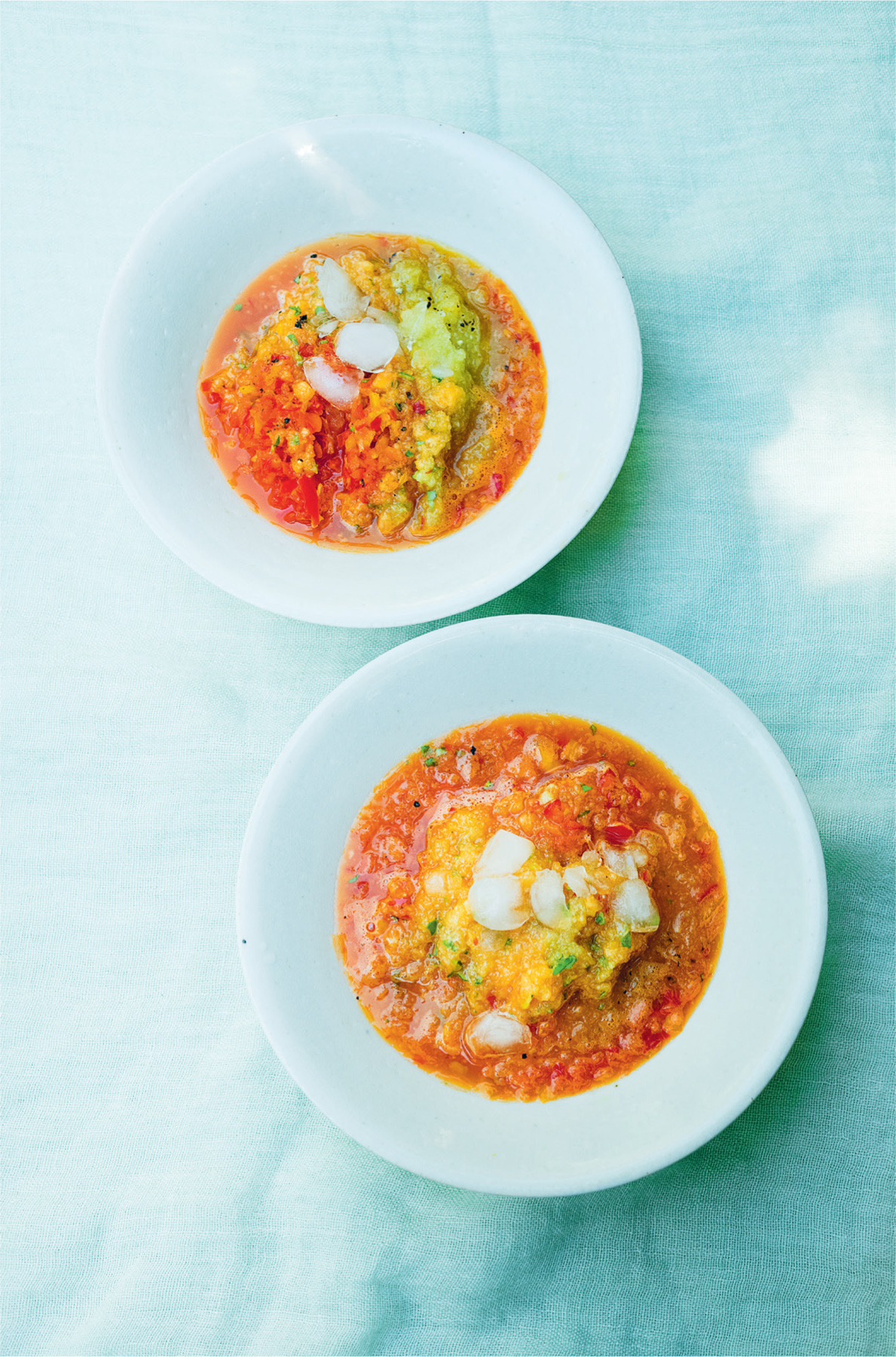
MELON, PEPPERS, CUCUMBER
Cold fruit soup. Refreshing. A deep scent of summer.
Serves 6
Romano peppers 3
a large yellow pepper
cucumber 250g
cantaloupe melon, ripe 1.25kg (unpeeled weight)
basil 10g
sherry vinegar 1 tablespoon
half a lemon
ice cubes
Halve and seed the peppers, then cut them into large pieces. Coarsely mince or process them to your preferred consistency, then put them in a large bowl. I prefer quite a smooth soup, but others like a more robust texture. Peel the cucumber and cut into rough chunks, then process to the same texture as the peppers and add to the bowl. Prepare the melon, discarding the skin, seeds and fibre, then cutting the flesh into chunks. Process in a similar way to the other ingredients, then mix with the peppers and cucumber.
Roughly chop the basil and stir into the soup together with the sherry vinegar, lemon juice and a little salt and black pepper. Cover and chill thoroughly. Stir in the ice cubes just before serving.
• A light, bright-tasting soup to serve chilled. By which I mean thoroughly cold and with ice cubes. The consistency can be as smooth or rough as you like, but I prefer it to have a coarse texture, so I use the mincer attachment to the food mixer. I have used a food processor too, but a careful eye is required to avoid reducing it to a purée.
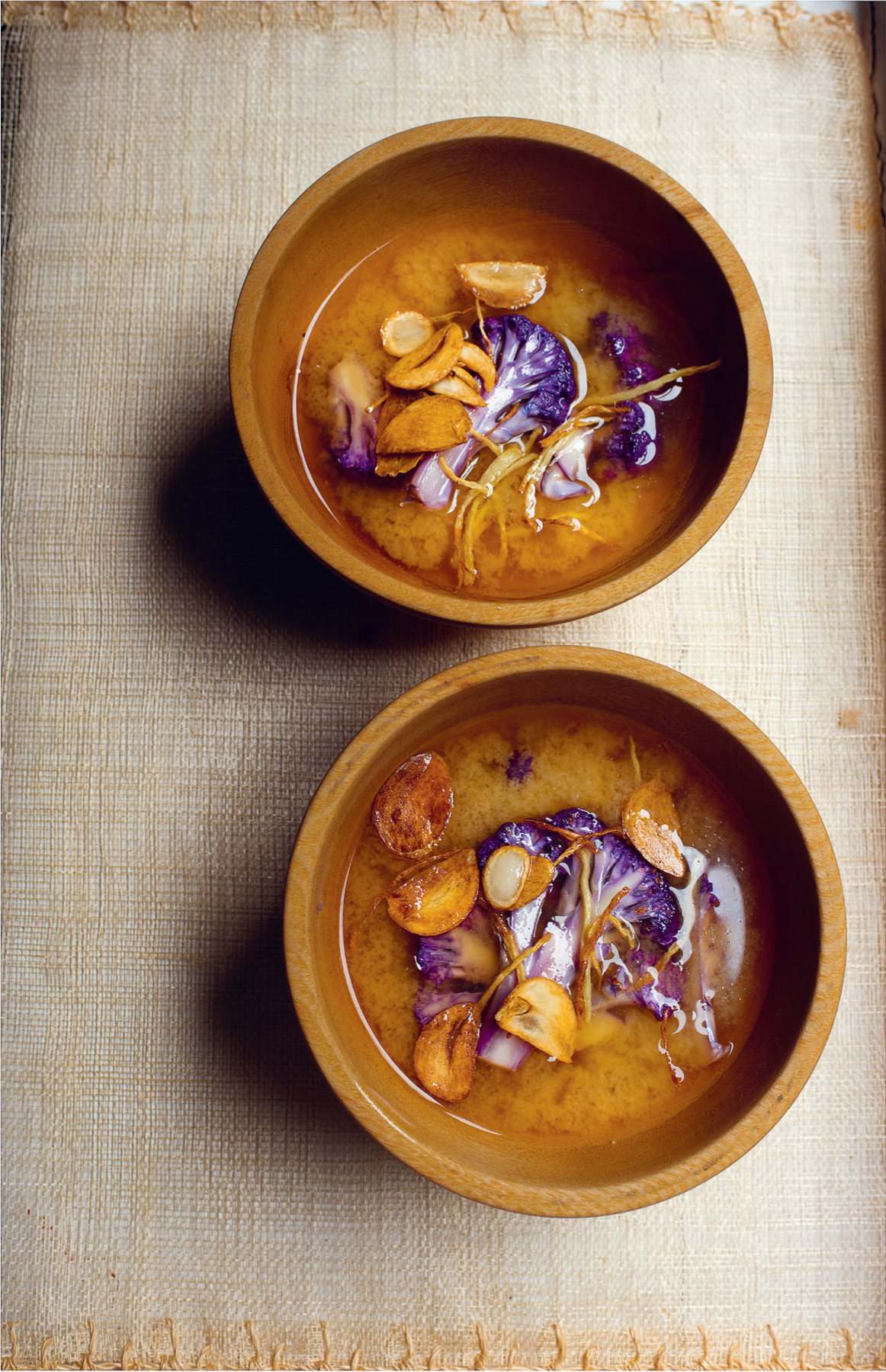
MISO, CAULIFLOWER, GINGER
Gentle soup for a spring day. The warmth of toasted garlic and ginger.
Serves 2
cauliflower 150g
garlic 2 cloves
ginger 30g
groundnut oil 2 tablespoons
dark miso paste 2 tablespoons
light miso paste 2 tablespoons
mirin 2 tablespoons
Cut the cauliflower into florets, then slice them thinly. Peel and thinly slice the garlic. Peel the ginger and cut into matchsticks.
Warm the groundnut oil in a shallow pan, then fry the garlic and ginger for a couple of minutes until pale and soft. Add the cauliflower, turning it over from time to time, letting it cook for four or five minutes until the slices colour lightly. By the time the cauliflower is cooked, the garlic should be a deep honey gold. Divide the cauliflower, garlic and ginger between four bowls.
Bring 1 litre of water to the boil, then stir in the miso pastes and the mirin. Simmer for two minutes, then ladle into the bowls over the cauliflower.
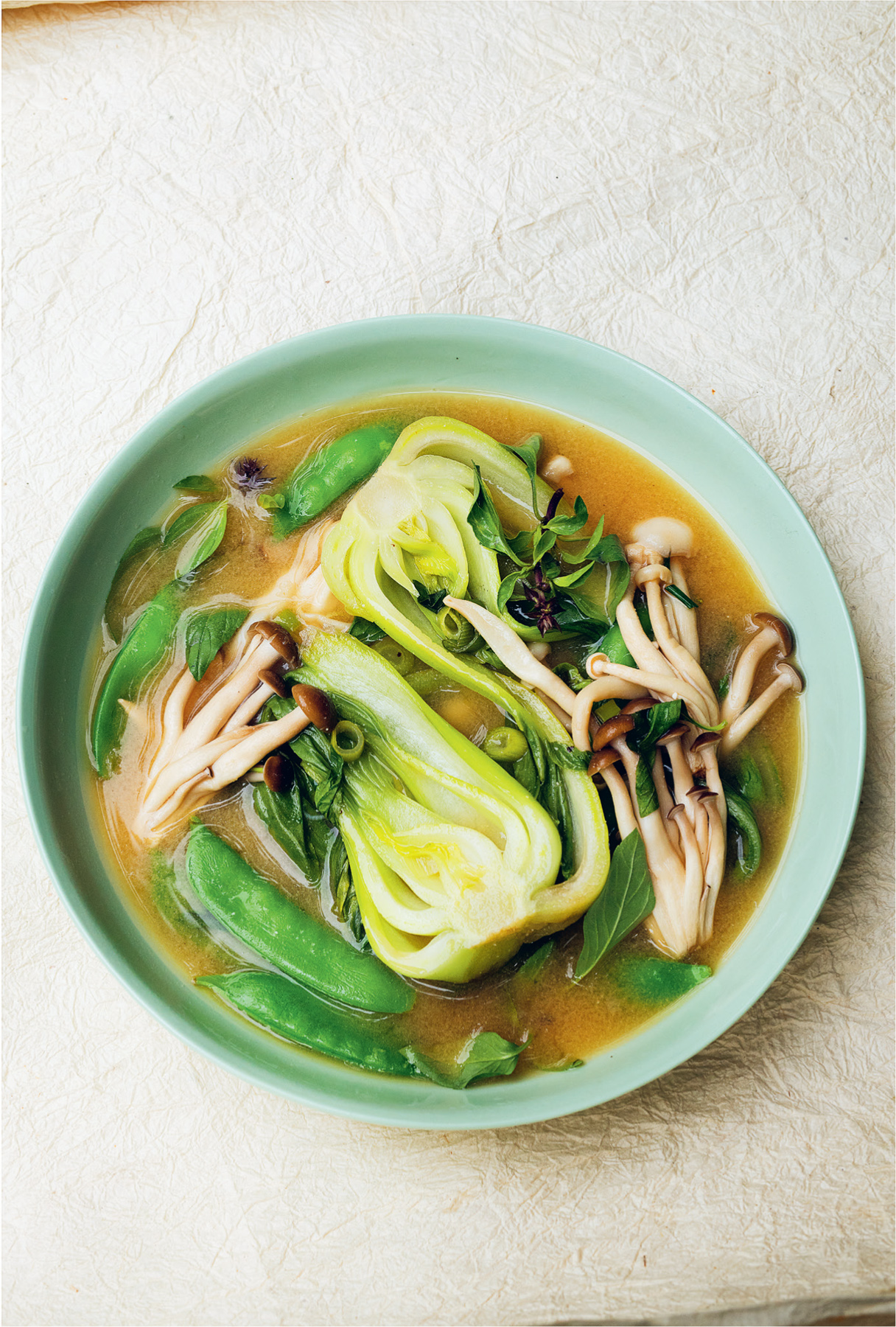
MISO, MUSHROOMS, PAK CHOI
Light, savoury, sustaining. A little bowl of calm.
Serves 4
sugar snap peas or shelled peas 150g
vegetable or chicken stock 750ml
white miso paste 4 tablespoons
spring onions 3
pak choi 125g
enoki mushrooms 100g
Thai basil a small bunch
a lime
light soy sauce
Bring a medium-sized pan of water to the boil. Add the sugar snaps or shelled peas and let them boil for two minutes, then lift them out with a slotted spoon and drop them into a bowl of cold water.
Warm the stock in a large pan. When the stock is hot, add the miso, stirring until it has dissolved. The stock should be very hot but not boiling. Finely slice the spring onions and add half to the stock. Halve the pak choi and push the pieces down into the stock. Remove and discard the roots from the enoki mushrooms, then add to the stock too.
Tear up the Thai basil leaves. Squeeze the juice from the lime. Divide the hot broth between four bowls, and add the remaining spring onions, the peas, basil leaves and the lime juice. Pass soy sauce around at the table, leaving everyone to season as they wish.
• Clear, light, gentle. I look upon this as something for those moments when you want a bowl of soup that is quietly sustaining rather than filling. A full-flavoured vegetable stock is essential, as is a generous hand with the seasoning. I tend to use chicken stock for this. I would leave the addition of soy sauce to individual diners. Just a little for me please, as I find soy sauce all too easily dominates everything in its path.

BULGUR, NECTARINES, PARSLEY
The comfort of grains. The sweetness of ripe fruit. The vibrancy of lemon and parsley.
Serves 2–3, as a main dish
vegetable or chicken stock or water 75ml
bulgur wheat 50g
radishes, mixed colours 20
nectarines, ripe 2
parsley 100g
juice of a large lemon
watercress 50g
Bring the stock or water to the boil. Put the bulgur in a heatproof bowl, pour over the hot stock or water, then set aside.
Trim and thinly slice the radishes and put them into a mixing bowl. Halve the nectarines, discard the stones, then finely dice the flesh into (roughly) 1cm cubes. Add to the radishes, then remove the parsley leaves from their stalks, chop finely and fold in.
Season the radishes and nectarines lightly with salt, then add the lemon juice. Drain any excess liquid from the bulgur, run a fork through the grains to separate them, then fold into the salad. Pile the watercress onto a serving dish, then spoon the bulgur on top and serve.
• Tabbouleh, of which this is a version, comes in many guises, but the most interesting are those that have far more parsley than grain. The herbs and fruit lend an essential lushness.
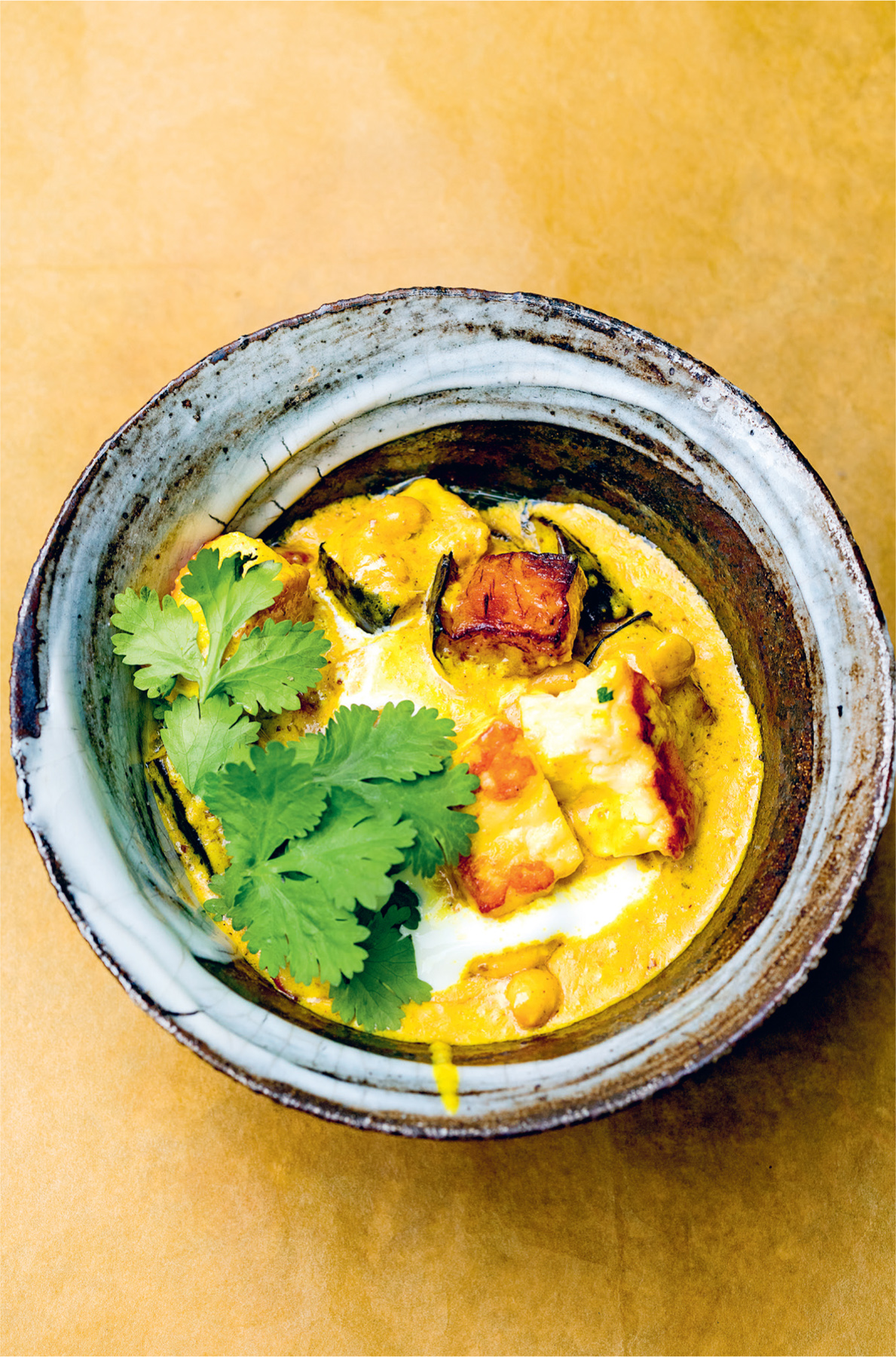
PANEER, AUBERGINE, CASHEWS
Gentle spice for a summer’s evening.
Serves 2–3 with rice or flatbread
For the spice mix:
garlic 2 cloves, peeled
ginger 20g, after peeling
ground turmeric 2 teaspoons
garam masala 2 teaspoons
ground coriander 2 teaspoons
ground cumin 2 teaspoons
cardamom pods 6
ground chilli 1 teaspoon
groundnut or olive oil 4 tablespoons
double cream 250ml
aubergine, medium 1
vegetable oil 3 tablespoons
paneer 200g
cashew nuts 100g
natural yoghurt 150ml
coriander leaves a small handful
Make the spice mix by grinding the garlic, ginger, turmeric, garam masala, ground coriander, cumin and the black seeds from inside the cardamom pods to a paste in a food processor or blender. Add the chilli and groundnut oil. Cook the paste over a low heat for four or five minutes, then stir in the double cream and a little salt. Set aside.
Cut the aubergine into 3cm cubes, then fry in the vegetable oil till soft and golden. Tear the paneer into rough pieces and add to the aubergine with the cashews, letting the nuts and paneer colour lightly. Add the warm spiced cream to the mixture, get it hot, then remove from the heat and stir in the yoghurt and the coriander leaves. Serve with warm flatbread.
• I sometimes add a pinch of sugar to the spice paste, softening the spices and producing a more mellow flavour.
• Rather than aubergine, I often use brown chestnut mushrooms instead, slicing them thickly and frying them in the oil before adding the paneer.
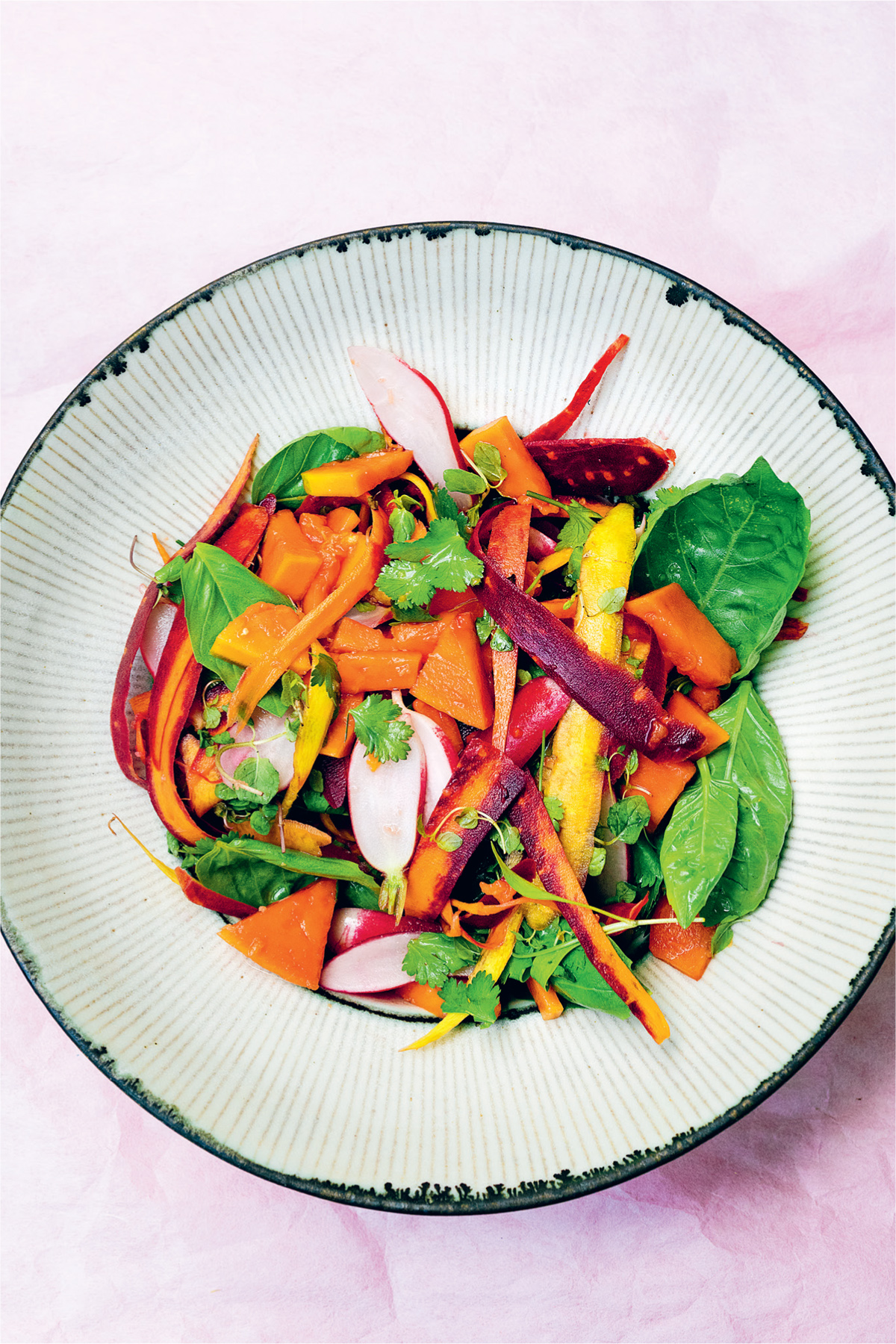
PAPAYA, CARROT, RADISH
The crunch of carrots. The warmth of radish and the honey-sweetness of ripe papaya.
Serves 4
radishes 12
carrots, medium 3
papaya, ripe 350g
coriander leaves from 12 bushy stems
micro herbs 2 handfuls
Thai basil leaves 15
For the dressing:
palm sugar 3 teaspoons
rice vinegar 2 tablespoons
a juicy lime
lemon grass 2 stalks
fish sauce 3 teaspoons
Make the dressing: crumble the palm sugar into a small mixing bowl and pour in the rice vinegar. Halve the lime – I like to roll it on the work surface, pressing down firmly as I do so before slicing, you get more juice that way – then squeeze the juice into the sugar and vinegar. Season with salt and stir until the sugar has dissolved.
Place the lemon grass on a chopping board and bash firmly with a rolling pin to split and crush the plump end of the stalks. Add them to the dressing with the fish sauce and leave for thirty minutes to infuse.
Halve the radishes and put them into a bowl of iced water. Scrub or peel the carrots, then shave them with a vegetable peeler into long thin shavings. Add them to the radishes.
Shortly before serving, when the radishes and carrots have spent twenty minutes in the iced water and the dressing is well infused, peel the papaya and discard the black seeds and fibres. Slice the fruit into small, thick pieces about the size of a stamp and put them in a large mixing bowl.
Pick the leaves from the coriander and add them to the papaya together with the micro herbs (leaves and stalks) and the whole Thai basil leaves. Dry the carrots in a salad spinner, then toss them and the radishes with the papaya and herbs. Discard the lemon grass stalks and pour the dressing over the papaya before tossing the ingredients gently together, taking care not to crush the fruit.
• I find the large papayas, usually sold in halves, best for salads. They seem to ripen better than the smaller fruit. Their flesh is more luscious. The downside is apparent when you realise that your purchase takes up an entire shelf in the fridge.

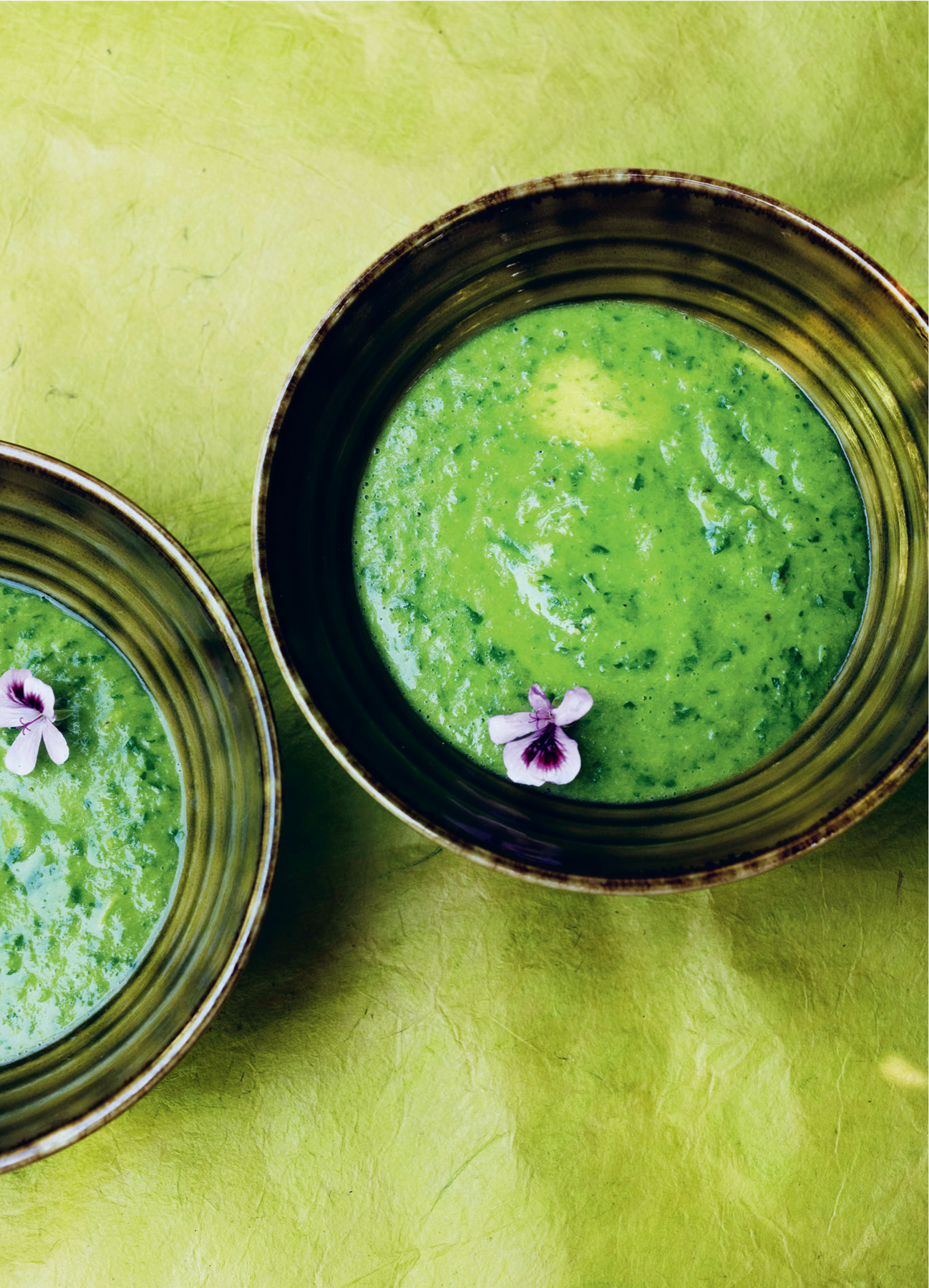
PEAS, PARSLEY, VEGETABLE STOCK
A green soup for a sunny day.
Serves 4, generously
butter 30g
spring onions 75g
flat-leaf parsley 300g
a medium potato
peas 200g (shelled weight)
garlic 2 cloves
vegetable or chicken stock 1 litre
Melt the butter in a large, heavy-based pan. Chop the spring onions and stir them into the butter, letting them cook for four to five minutes over a moderate heat.
Chop half the parsley, stalks and all, add it to the spring onions and leave to cook for a minute or two till the colour has darkened. Peel, dice and add the potato. Add the peas and peeled garlic and pour in the stock. Bring to the boil, then lower the heat to a simmer and cook for eight to ten minutes.
Put a pan of water on to boil. Discard the stalks from the reserved parsley, add the leaves to the boiling water and leave for two minutes, then drain. Stir the leaves into the soup, then remove from the heat and reduce to a smooth, green purée in a blender or food processor and serve.
• The brilliant vibrancy of this soup appeals here, but you could soften its healthy green edges by stirring in 100ml of double cream at the end. Take care not to overfill the blender in case the hot soup overflows. I only say this because I invariably do.
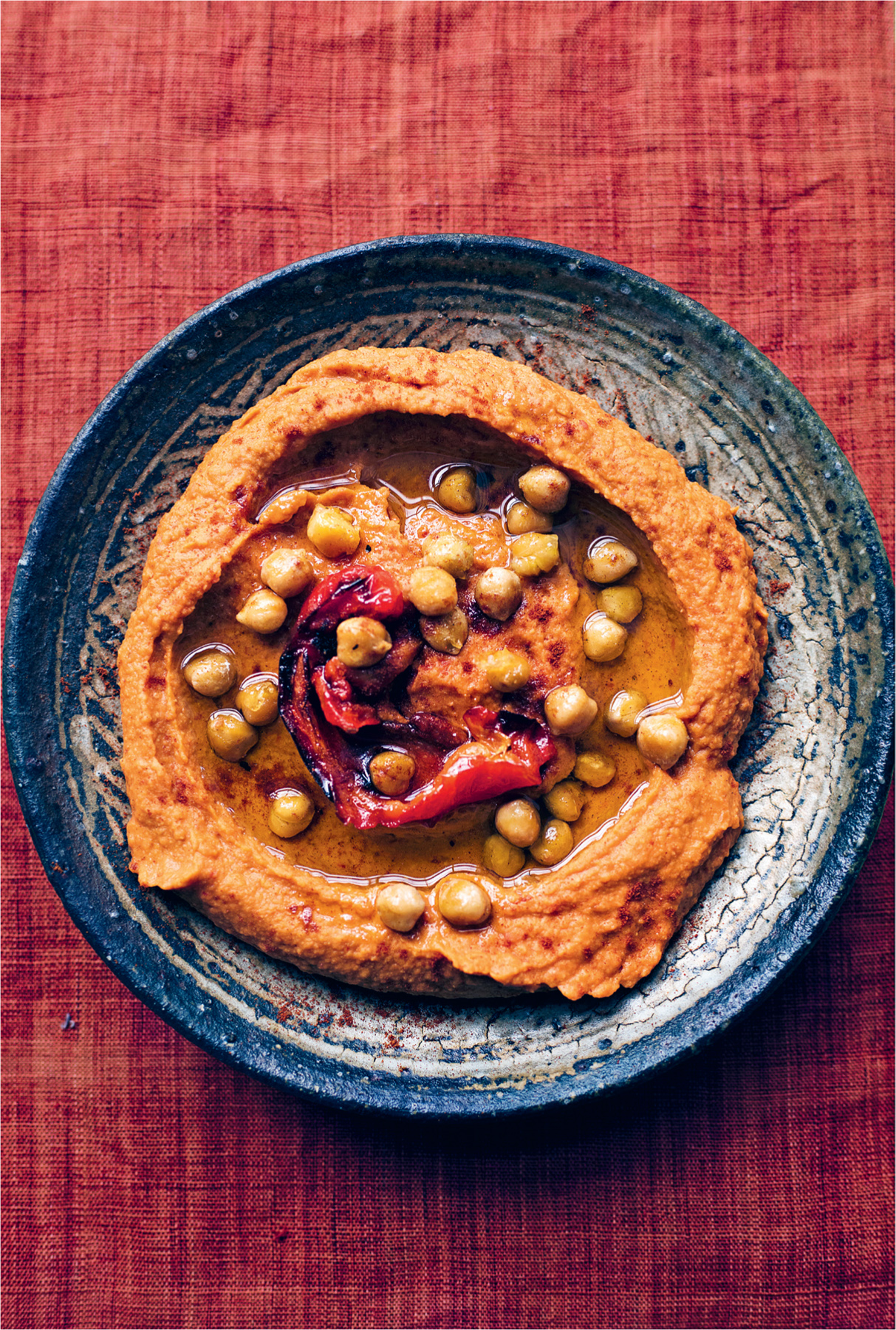
PEPPERS, CHICKPEAS, GARLIC
Earthy and garlicky. A smooth cream for warm flatbread.
Serves 4, as a side dish
red peppers 500g
olive oil
garlic 6 cloves
chickpeas 2 × 400g cans
thyme 4 sprigs
bay leaves 2
paprika a pinch or two
Set the oven at 200°C/Gas 6. Slice the peppers in half lengthways, remove the seeds, then place the halves in a roasting tin. Trickle a little olive oil over the peppers, just enough to wet them, then set the unpeeled garlic cloves inside them. Bake for forty minutes or until they are soft and the skin somewhat blackened. Remove from the oven, then peel away their outer skins. Reserve the garlic and any juices in the roasting tin.
Drain and rinse the chickpeas, pop them from their skins if you wish, then tip them into a saucepan, add the thyme and bay and cover with water. Bring to the boil, lower the heat, then simmer for fifteen minutes.
Drain the cooked chickpeas, reserve the thyme (discard the bay), then tip all but a handful of the chickpeas into the bowl of a food processor with the roasted, skinned peppers. Add the thyme leaves (discard the stalks) then pop the roasted garlic from its skin and add it as well. Process to a smooth cream and season generously with salt and black pepper. Scoop the paste out into a serving dish, making a hollow in the centre with the back of a spoon.
Heat the reserved chickpeas in a little olive oil in a frying pan and cook for a few minutes till they start to turn gold. Pour a little olive oil over the paste, letting it trickle into the hollow, scatter the warm chickpeas over the surface, then dust lightly with the paprika.
• A hummus of sorts. (I am uncomfortable with calling something by that name that contains anything other than chickpeas, garlic, lemon and oil.) I do think it is worth skinning the chickpeas (I know, I know, but once you have done so, you may never look back). You can do it painstakingly, pea by pea, or simply rub them together in your palms, a handful at a time. Either way will result in a smoother mash. Your call.
• I have been known to sit with this and a pile of warm Turkish pitta, but it is also a fine side dish for cold roast meats, grilled aubergines, and my favourite, deep-fried artichokes.

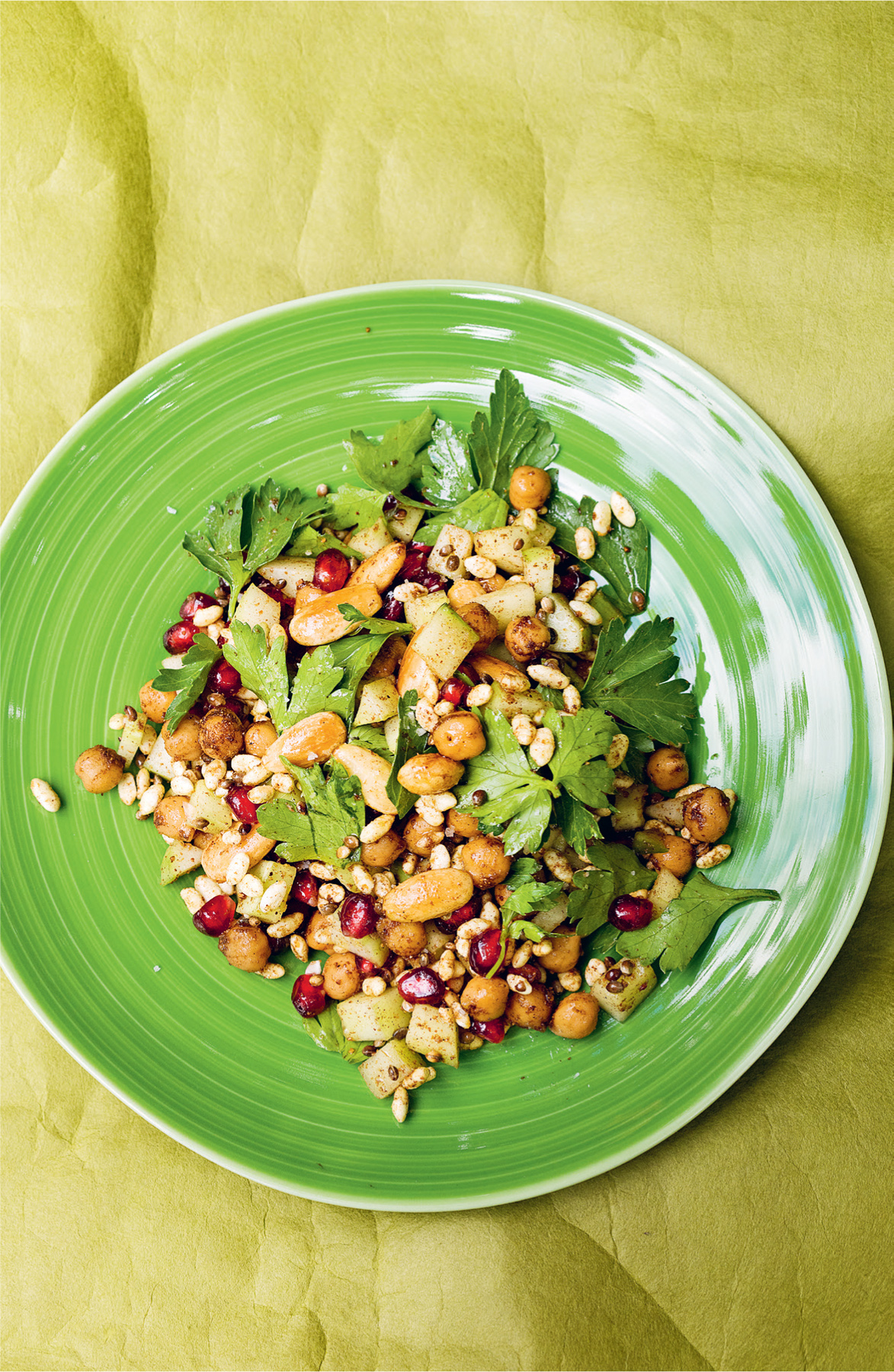
POMEGRANATE, CUCUMBER, PUFFED RICE
Aromatic, crunchy, refreshing.
Serves 4, as a side salad
a small pomegranate
cucumber 400g
coriander seeds 1 teaspoon
cumin seeds 1 teaspoon
groundnut oil 2 tablespoons
garam masala 1 teaspoon
curry powder 1 teaspoon
almonds 50g, whole and skinned
chickpeas 1 × 400g can
hemp seeds 30g
sunflower seeds 30g
puffed rice, unsweetened 30g
parsley a handful
olive oil
Crack open the pomegranate and remove the seeds, putting them into a mixing bowl and discarding any white pith as you go. Peel the cucumber, lightly, leaving as much colour as you can, then cut in half lengthways. Scrape out the seeds and pith with a teaspoon and discard, then cut the flesh into small dice. Toss the cucumber and pomegranate together.
Put the coriander and cumin seeds in a shallow pan and warm them over a gentle heat. Let them cook, moving them around the pan, until crisp and fragrant. Remove the pan from the heat and tip the toasted seeds into a mortar. Crush them to a fine powder.
Warm the groundnut oil in the shallow pan, then, keeping the heat low, add the coriander and cumin, garam masala and curry powder, then the almonds. Warm the nuts and spices, moving everything round the pan so it doesn’t burn. Drain and rinse the chickpeas and stir them into the spices and almonds, together with the hemp and sunflower seeds and the puffed rice. Tear the parsley leaves from their stalks and add to the bowl. Tip the warm chickpea mixture into the pomegranate and cucumber, add a trickle of olive oil, then toss gently together and serve.
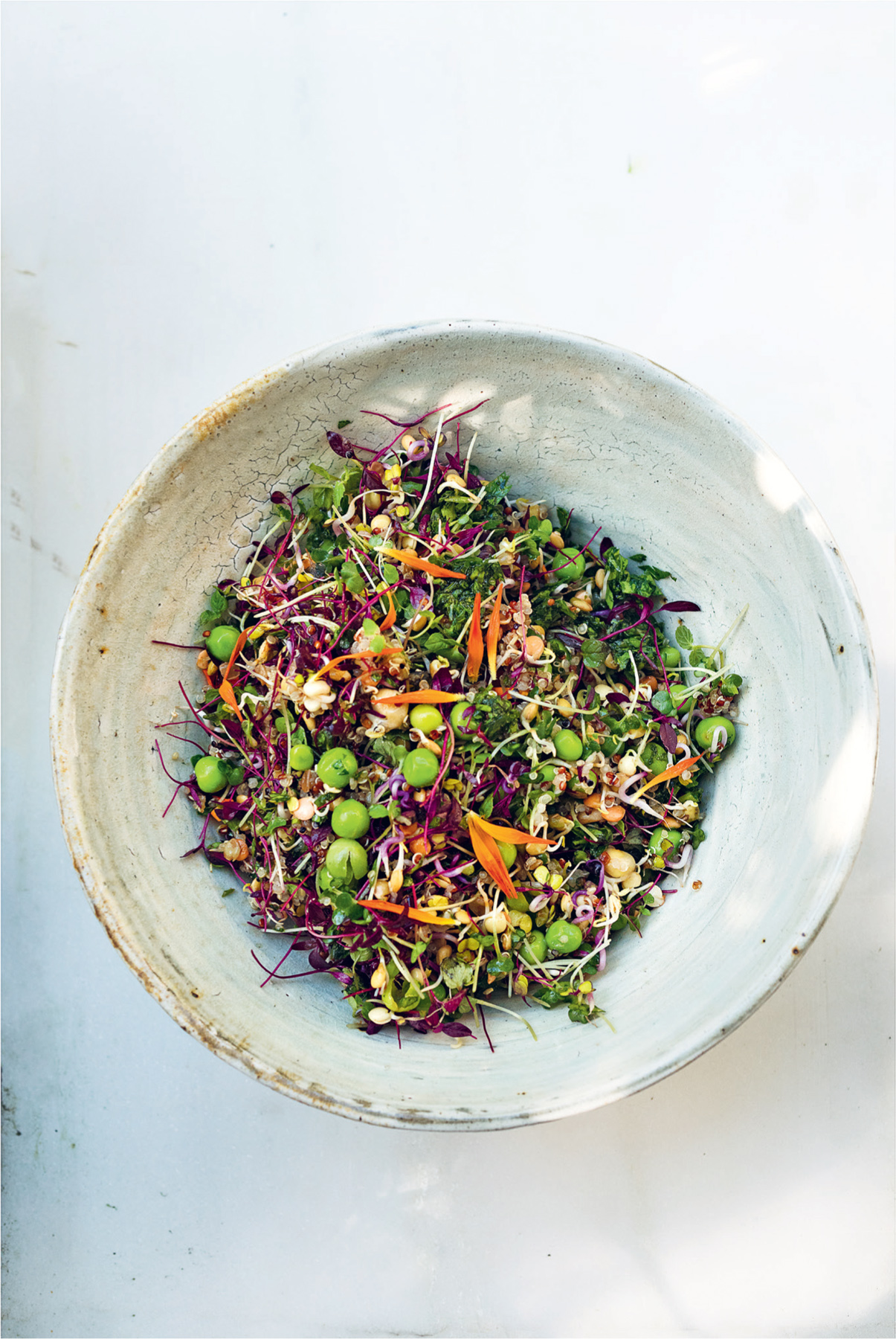
QUINOA, PEAS, SPROUTED SEEDS
Soft leaves, crunchy, lightly cooked peas. The knubby quality of quinoa.
Serves 6
quinoa 100g
peas 400g (weight with pods)
sprouted mung, sunflower and radish seeds 100g
cress a small punnet
micro leaves and marigold petals a large handful
For the dressing:
pomegranate molasses 2 tablespoons
lemon juice 2 tablespoons
olive oil 2 tablespoons
Put the quinoa into a pan with 175ml of water and bring to the boil. Reduce the heat and simmer for six minutes before turning off the heat and leaving, covered, for twenty minutes.
Pod the peas and cook them in deep, lightly salted boiling water for four minutes or until they are almost tender. (They are good when slightly undercooked.) Drain and plunge them into iced water.
Mix the pomegranate molasses, lemon juice and olive oil together in a large mixing bowl and season lightly. Run a fork through the quinoa to separate the grains, then tip into the dressing.
Wash the sprouted seeds in a sieve in cold running water and shake dry. Mix the peas, seeds, cress, micro leaves and petals with the quinoa and its dressing and serve.
• Once made, this is a good base in which to use other leftovers, torn into juicy pieces, or simply to put on the table with other dishes. I should add that it makes a sound addition to lunchboxes, and will be fine in the fridge for a couple of days.
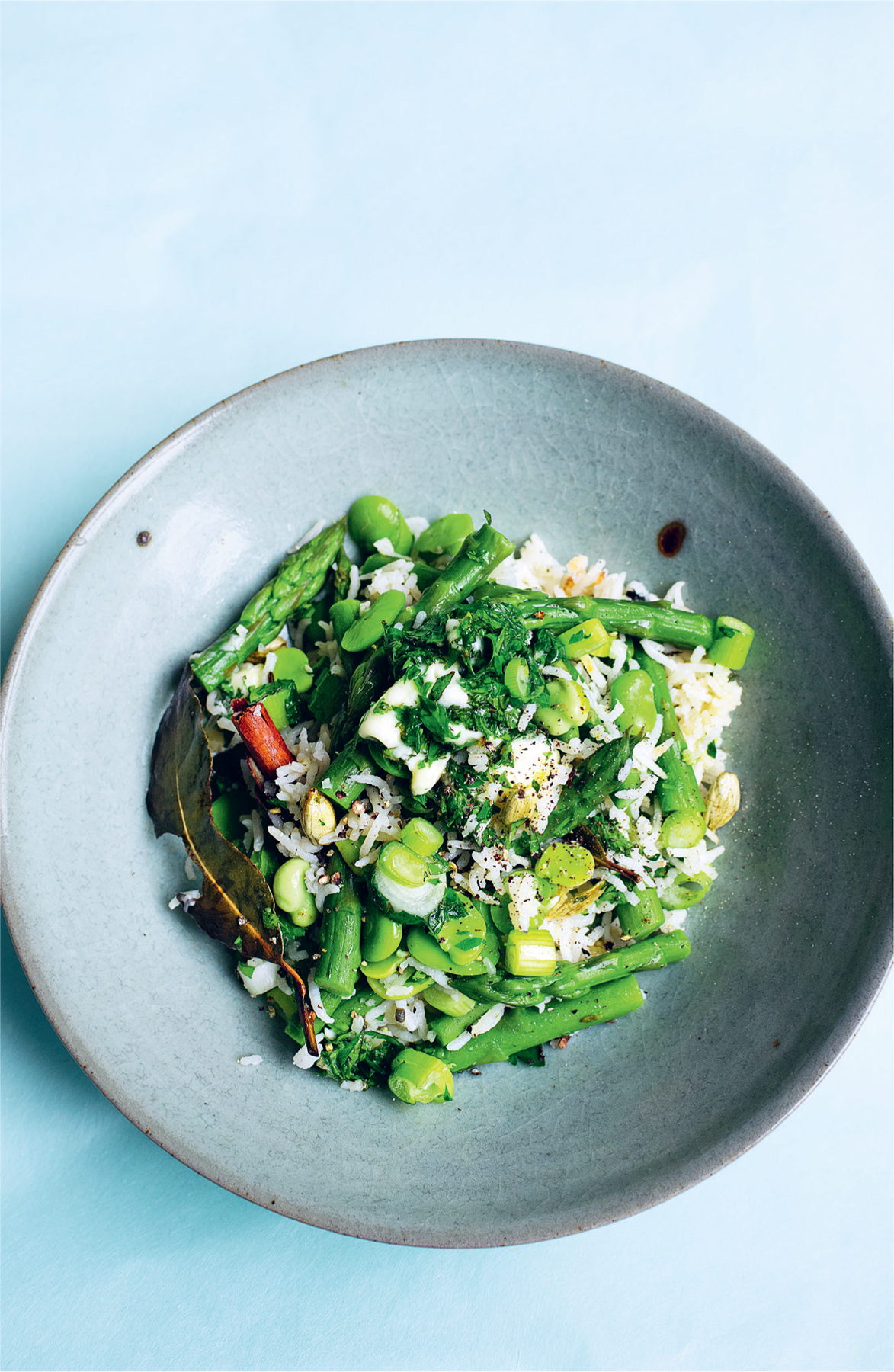
RICE, BROAD BEANS, ASPARAGUS
Homely buttered rice. The luxury of new season’s vegetables.
Serves 2–3
broad beans, podded a couple of handfuls
asparagus 18 spears
For the pilaf:
white basmati rice 120g
butter 50g
bay leaves 3
green cardamom pods 6
black peppercorns 6
a cinnamon stick
cloves 2 or 3
cumin seeds a pinch
thyme a couple of sprigs
For the herb butter:
mint leaves 8 large
parsley a small handful
spring onions 2
butter, soft 200g
Cook the beans in deep, lightly salted boiling water for three or four minutes. Drain and pop the largest of the beans from their skins. Any very small beans can be left as they are. Trim the asparagus, removing any tough ends, then cut the spears into short lengths. Boil or steam for five or six minutes until just tender.
Wash the rice three times in a bowl of warm water. This will prevent it sticking together. Melt the butter in a saucepan over a moderate heat, add the bay leaves, the cardamom pods, lightly crushed, peppercorns, cinnamon stick, cloves, cumin seeds and sprigs of thyme. Stir the spices and herbs around in the butter for a minute or two, then, as soon as they are warm and fragrant, drain the rice and add it to the pan. Stir the rice to coat it with the butter, then pour in enough water to cover and leave 2cm of water above the rice.
Season with salt, turn down the heat so the water simmers and cover tightly with a lid. After seven minutes, lift the lid, and fold in the drained asparagus and the broad beans. Replace the lid and continue cooking for a further five minutes. Remove from the heat, leave the lid in place and set aside for three minutes.
Make the butter: put the mint leaves on top of one another, roll them up tightly, then shred them finely. Remove the parsley leaves from their stalks and finely chop. Discard the roots and the darkest green shoots of the spring onions. Finely chop the white and pale green part.
Cream the butter until it is soft and fluffy. Season with a little coarsely ground black pepper and sea salt. Fold in the mint, parsley and spring onions.
Lift the lid from the rice, stir with a fork to separate the grains, then fold in the herb butter. Alternatively, divide the rice between plates, place a spoonful of the herb butter on the hot rice and fold in so the grains are coated.
• If you make the butter in advance, remove it from the fridge a good half hour before using. It should be soft and fluffy.

